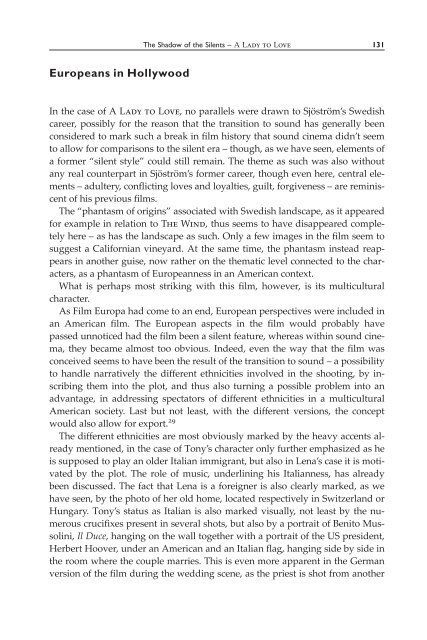FILM FILM - University of Macau Library
FILM FILM - University of Macau Library
FILM FILM - University of Macau Library
Create successful ePaper yourself
Turn your PDF publications into a flip-book with our unique Google optimized e-Paper software.
Europeans in Hollywood<br />
The Shadow <strong>of</strong> the Silents – A Lady to Love 131<br />
In the case <strong>of</strong> A Lady to Love, no parallels were drawn to Sjöström’s Swedish<br />
career, possibly for the reason that the transition to sound has generally been<br />
considered to mark such a break in film history that sound cinema didn’t seem<br />
to allow for comparisons to the silent era – though, as we have seen, elements <strong>of</strong><br />
a former “silent style” could still remain. The theme as such was also without<br />
any real counterpart in Sjöström’s former career, though even here, central elements<br />
– adultery, conflicting loves and loyalties, guilt, forgiveness – are reminiscent<br />
<strong>of</strong> his previous films.<br />
The “phantasm <strong>of</strong> origins” associated with Swedish landscape, as it appeared<br />
for example in relation to The Wind, thus seems to have disappeared completely<br />
here – as has the landscape as such. Only a few images in the film seem to<br />
suggest a Californian vineyard. At the same time, the phantasm instead reappears<br />
in another guise, now rather on the thematic level connected to the characters,<br />
as a phantasm <strong>of</strong> Europeanness in an American context.<br />
What is perhaps most striking with this film, however, is its multicultural<br />
character.<br />
As Film Europa had come to an end, European perspectives were included in<br />
an American film. The European aspects in the film would probably have<br />
passed unnoticed had the film been a silent feature, whereas within sound cinema,<br />
they became almost too obvious. Indeed, even the way that the film was<br />
conceived seems to have been the result <strong>of</strong> the transition to sound – a possibility<br />
to handle narratively the different ethnicities involved in the shooting, by inscribing<br />
them into the plot, and thus also turning a possible problem into an<br />
advantage, in addressing spectators <strong>of</strong> different ethnicities in a multicultural<br />
American society. Last but not least, with the different versions, the concept<br />
would also allow for export. 29<br />
The different ethnicities are most obviously marked by the heavy accents already<br />
mentioned, in the case <strong>of</strong> Tony’s character only further emphasized as he<br />
is supposed to play an older Italian immigrant, but also in Lena’s case it is motivated<br />
by the plot. The role <strong>of</strong> music, underlining his Italianness, has already<br />
been discussed. The fact that Lena is a foreigner is also clearly marked, as we<br />
have seen, by the photo <strong>of</strong> her old home, located respectively in Switzerland or<br />
Hungary. Tony’s status as Italian is also marked visually, not least by the numerous<br />
crucifixes present in several shots, but also by a portrait <strong>of</strong> Benito Mussolini,<br />
Il Duce, hanging on the wall together with a portrait <strong>of</strong> the US president,<br />
Herbert Hoover, under an American and an Italian flag, hanging side by side in<br />
the room where the couple marries. This is even more apparent in the German<br />
version <strong>of</strong> the film during the wedding scene, as the priest is shot from another

















